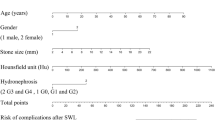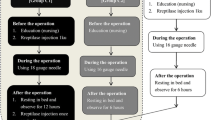Abstract
Purpose
To develop a new prediction model for assessing the severe hemorrhage events in post mini-percutaneous nephrolithotomy (mini-PCNL) patients and internally validate it, thus to guide decision making in clinical practice.
Methods
The patients who underwent mini-PCNL were retrospectively reviewed. Potential risk factors were included as prediction variables for multivariate logistic regression analysis to identify independent risk factors, and prediction model was constructed. The predictive ability of the model was evaluated using the Concordance index (C-index) and Brier score. Bootstrapping resampling technique was used to perform internal validation. The related packages in R were used to generate the web application based on the prediction model.
Results
Multiple-tract was the strongest predictor of severe hemorrhage following mini-PCNL. Other risk factors were none or mild hydronephrosis, congenital anomalies of urinary system, urinary tract infection, operation time and stone peak Hounsfield unit. A prediction model was constructed to assess the probability of severe hemorrhage after mini-PCNL. The C-index and Brier score were 0.731 and 0.093, respectively after correcting for optimism, which signified the excellent discrimination and calibration.
Conclusion
A new prediction model was developed to estimate risk of severe hemorrhage after mini-PCNL. It had been internally validated with good discrimination and calibration. The prediction model might be beneficial for endourologists in surgical decision-making and risk aversion.


Similar content being viewed by others
Data availability
The data that support the findings of this study are available from the corresponding author upon reasonable request.
References
Fernström I, Johansson B (1976) Percutaneous pyelolithotomy. A new extraction technique. Scand J Urol Nephrol 10(3):257–259
Skolarikos A, Neisius A, Petřík A et al. EAU guidelines on urolithiasis. https://uroweb.org/guidelines/urolithiasis/chapter/guidelines
Zeng G, Zhong W, Mazzon G et al (2022) International Alliance of Urolithiasis (IAU) guideline on percutaneous nephrolithotomy. Minerva Urol Nephrol
Keoghane SR, Cetti RJ, Rogers AE et al (2013) Blood transfusion, embolisation and nephrectomy after percutaneous nephrolithotomy (PCNL). BJU Int 111(4):628–632
de la Rosette J, Assimos D, Desai M et al (2011) The Clinical Research Office of the Endourological Society Percutaneous Nephrolithotomy Global Study: indications, complications, and outcomes in 5803 patients. J Endourol 25(1):11–17
Michel MS, Trojan L, Rassweiler JJ (2007) Complications in percutaneous nephrolithotomy. Eur Urol 51(4):899–906 (discussion 906)
Nouralizadeh A, Ziaee SA, Hosseini Sharifi SH et al (2014) Delayed postpercutaneous nephrolithotomy hemorrhage: prevalence, predictive factors and management. Scand J Urol 48(1):110–115
Seitz C, Desai M, Häcker A et al (2012) Incidence, prevention, and management of complications following percutaneous nephrolitholapaxy. Eur Urol 61(1):146–158
Ran R, Zhang R, Xie Y et al (2021) Decreased hemoglobin as a quantifiable indicator of renal arterial embolization in post-percutaneous nephrolithotomy hemorrhage. Urolithiasis 49(2):137–143
Lee JK, Kim BS, Park YK (2013) Predictive factors for bleeding during percutaneous nephrolithotomy. Korean J Urol 54(7):448–453
El-Nahas AR, Shokeir AA, El-Assmy AM et al (2007) Post-percutaneous nephrolithotomy extensive hemorrhage: a study of risk factors. J Urol 177(2):576–579
Kukreja R, Desai M, Patel S et al (2004) First prize: factors affecting blood loss during percutaneous nephrolithotomy: Prospective Study. J Endourol 18(8):715–722
Thomas K, Smith NC, Hegarty N et al (2011) The Guy’s stone score–grading the complexity of percutaneous nephrolithotomy procedures. Urology 78(2):277–281
Syahputra FA, Birowo P, Rasyid N et al (2016) Blood loss predictive factors and transfusion practice during percutaneous nephrolithotomy of kidney stones: a prospective study. F1000Res 5:1550
Arora AM, Pawar PW, Tamhankar AS et al (2019) Predictors for severe hemorrhage requiring angioembolization post percutaneous nephrolithotomy: a single-center experience over 3 years. Urol Ann 11(2):180–186
Kartal I, Çakıcı MÇ, Selmi V et al (2019) Retrograde intrarenal surgery and percutaneous nephrolithotomy for the treatment of stones in horseshoe kidney; what are the advantages and disadvantages compared to each other? Cent European J Urol 72(2):156–162
Dong X, Wang D, Zhang H et al (2021) No staghorn calculi and none/mild hydronephrosis may be risk factors for severe bleeding complications after percutaneous nephrolithotomy. BMC Urol 21(1):107
Du N, Ma JQ, Luo JJ et al (2019) The efficacy and safety of transcatheter arterial embolization to treat renal hemorrhage after percutaneous nephrolithotomy. Biomed Res Int 22(2019):6265183
El Tayeb MM, Knoedler JJ, Krambeck AE et al (2015) Vascular complications after percutaneous nephrolithotomy: 10 years of experience. Urology 85(4):777–781
Akman T, Binbay M, Sari E et al (2011) Factors affecting bleeding during percutaneous nephrolithotomy: single surgeon experience. J Endourol 25(2):327–333
Funding
Not applicable.
Author information
Authors and Affiliations
Contributions
ZZX: project development, data collection and analysis, manuscript writing; XJD: project development, data collection and analysis; LZF, MLYF, ZWZ and YZY: data collection and analysis; ZW: project development, interpretation of data, drafting and revising the manuscript.
Corresponding author
Ethics declarations
Conflict of interest
All the authors declare that they have no conflict of interest.
Additional information
Publisher's Note
Springer Nature remains neutral with regard to jurisdictional claims in published maps and institutional affiliations.
Supplementary Information
Below is the link to the electronic supplementary material.
Rights and permissions
Springer Nature or its licensor (e.g. a society or other partner) holds exclusive rights to this article under a publishing agreement with the author(s) or other rightsholder(s); author self-archiving of the accepted manuscript version of this article is solely governed by the terms of such publishing agreement and applicable law.
About this article
Cite this article
Zheng, Z., Xu, J., Li, Z. et al. Development and internal validation of a prediction model to evaluate the risk of severe hemorrhage following mini-percutaneous nephrolithotomy. World J Urol 41, 843–848 (2023). https://doi.org/10.1007/s00345-023-04291-5
Received:
Accepted:
Published:
Issue Date:
DOI: https://doi.org/10.1007/s00345-023-04291-5




